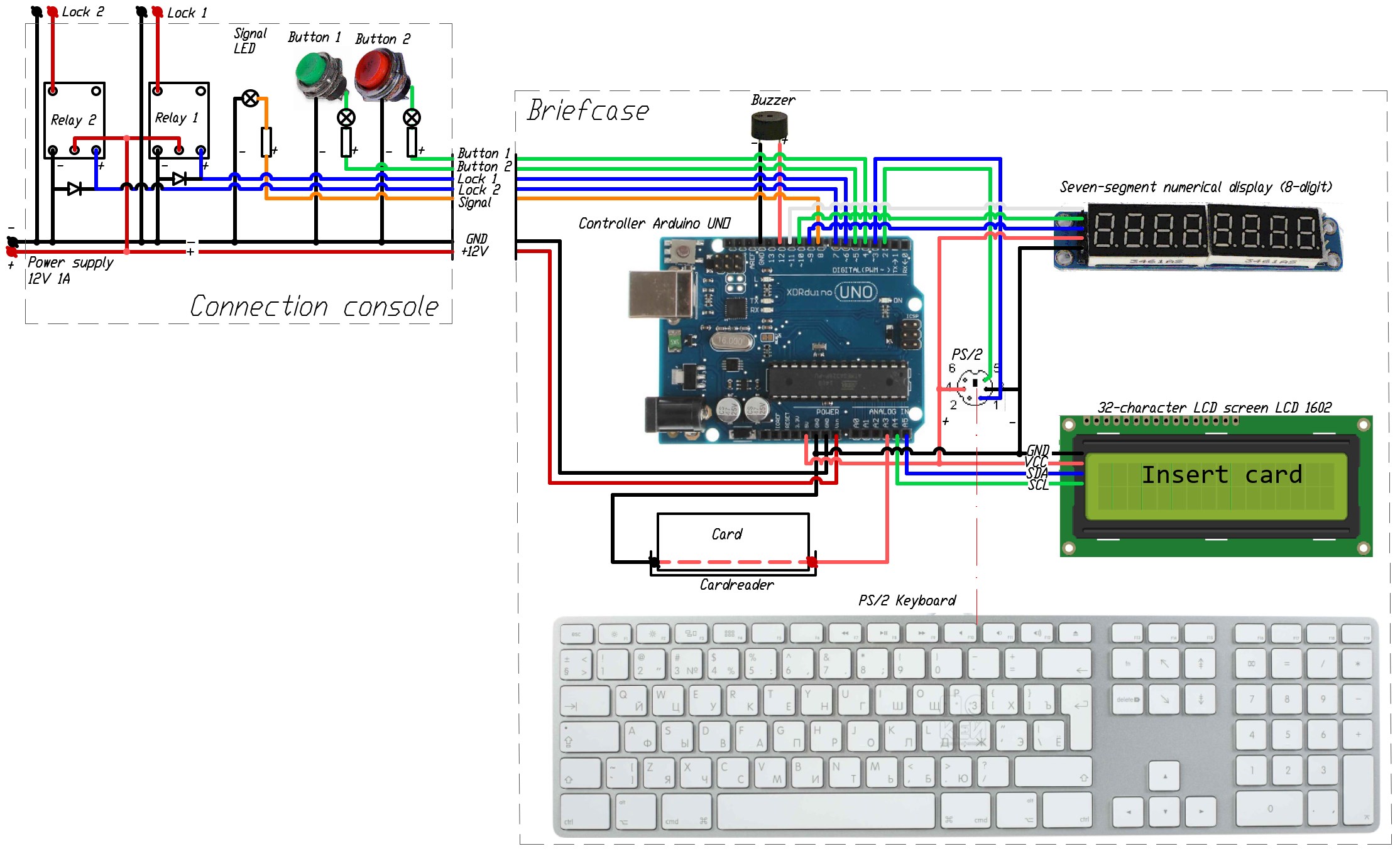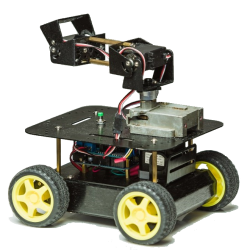Briefcase with riddles to use in escape room amusement
According to the plot of the game, the briefcase is part of the puzzle and must be used in a chain of tasks to open the exit door.
The briefcase can be connected to a stationary connection console from which the door lock is unlocked.
All actions are accompanied by messages on numerical display, character LCD screen and sound signals from a buzzer.
The control elements inside the briefcase are:
- Card reader for card reading
- Standard full-size computer keyboard for entering passwords and numeric codes
- 8-digit display for displaying digital codes.
- 32-character LCD screen for displaying password and explanations
- Buzzer for sound signals
- Electrical connector for connecting the diplomat to the remote control
On the stationary console there are:
- Two buttons for opening doors, covered with a transparent cover
- Electric lock that locks the transparent cover
- Electric lock that blocks the opening of the exit door
- Signal LED
Operation logic
The system includes several “riddles” that must be solved sequentially:
- The briefcase must be found in a secret place inside the room
- The unlock card must be found in another secret location
- The suitcase must be connected to the stationary console with a cable, after which a sound signal will sound and the
Insert cardrequest will appear on the character screen. - The player inserts a card
- Card inserted – The character screen displays
password:and the cursor flashes. The numerical display displays a random set of numbers (changing every 0.3-0.5 seconds). The digital block does not respond to pressing; - Card removed – The symbol screen displays
Insert card;
- Card inserted – The character screen displays
- The player begins to enter the code from the keyboard
- Entering a symbol or number – displayed on the screen;
del,backspace– deleting the last character;esc– deletes all entered characters;enter– enter a password;- The rest of the buttons - nothing happens and a short buzzer;
- The player entered the password and pressed
enter- Wrong password – long buzzer,
wrong passwordflashes on the screen three times with a pause of 0.5 seconds. Then everything goes back to the beginning of entering the password; - The password is correct –
correct passwordis displayed on the character screen for 10 seconds. The change of numbers on the numerical display stops - a certain sequence of 8 digits is displayed. The character screen displayscode decryptedThe LED next to the number pad begins to blink. The alphabetic keyboard stops responding to keystrokes;
- Wrong password – long buzzer,
- The player starts typing the numbers on the number pad
- Each press is accompanied by a flash on the numeric display and a short buzzer tone.
- All 8 digits entered and presseed
#(as it will be signed asokon the numeric keypad)- The code is incorrect – the buzzer is long, the numbers on the numerical scoreboard flash twice and light up again;
- The code is correct – the numbers on the numerical board are extinguished. The
correct codeis displayed on the symbol screen. A signal is given to unlock the magnetic lock of the button cover on the main stationary console;
- The electric lock, which locks the transparent lid, is unlocked and two buttons become available
- The player presses one of the buttons – nothing happens, a short buzzer;
- The player presses two buttons at the same time – the lamp between the buttons lights up, the long buzzer comes on, the electric lock of the exit door is unlocked;
System parameters:
- Main controller – Arduino Uno
- Processor – 16 MGh, ATmega328P
- Controller memory – 32 KB Flash + 2 kB SRAM + 1kB EEPROM
- LCD screen – LCD 1602
- Screen size – 64.5x13.8 mm
- Character size – 4.35x2.95 mm
- Pixel size – 0.5x0.5 mm
- Seven-segment display – 8-digit
- Dispay size – 100x19mm
- Digit size – 8x14.2mm
- Power supply – 12V 2A
- Briefcase dimensions – 440x320x120 mm
Components
- Controller Arduino UNO
- Full-size computer keyboard with PS2 connector
- Seven-segment numerical display (8-digit)
- 32-character LCD screen LCD1602
- 5V buzzer
- Card reader
- Standard buttons – 2pcs
- Signal led
- Electric lock – 2pcs
Wiring diagram

Further development of the system
-
Improvements to puzzle plots;
-
Adding internal power supply and wireless connection;
-
Adding speakers and audio feedback in the form of recorded audio messages;
-
Adding a full TFT display to display graphics;

 Books
Books Technology
Technology Electronics
Electronics Programming
Programming Weaponry
Weaponry Arduino
Arduino Projects
Projects